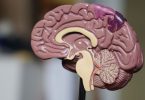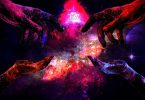Decoctions of the Banisteriopsis caapi vine, the Psychotria viridis shrub, both native to South America, produce the murky liquor called ayahuasca, aka yage. Ayahuasca offers a natural, bewitching option for treating depression. [1-3] Like other psychedelics we’ve explored such as ketamine, psilocybin, or an upcoming discussion on ibogaine, what’s remarkable about the medicinal aspects of these psychedelic molecules is that they work fast. Clinical trials have demonstrated this for ayahuasca with study participants reporting significant antidepressant effects after just one day. [1-3] After one session, where participants consumed 120-200 mL (approximately 4-7 ounces) of an ayahuasca decoction (2.2 mL/kg body weight), beneficent aftereffects survived for 3 weeks. [1,2] The decoction contained approximately 0.8 mg/mL of N,N-dimethyltryptamine or DMT.
Ayahuasca has articulated its medicinal prowess, and the scientists who have bothered to study the plant appreciate this. The riddle they currently seek to solve is how this all works. A 2020 study sought these answers [4], but to understand their method, we must first dive into the salience and default mode networks.
Says Lucina Q. Uddin in Salience Network of the Human Brain, “The salience network is a collection of regions of the brain that select which stimuli are deserving of our attention.” [5] The default mode network (DMN) regards a large portion of our brains that activates when we turn our minds inward to wander and daydream, not focused on the outside world. [6] The DMN turns on when we reflect on our pasts or contemplate our futures. It’s thought to be the foundation of the self, what makes you you in your own mind.
The salience network modulates our ability to switch between the DMN (e.g., daydreaming) and the central executive network which involves our thinking about tasks at hand and achieving a defined goal via problem solving and our working memory (focusing). [7] Interestingly, salience network abnormalities are associated with mental health issues like post-traumatic stress disorder, anxiety, and schizophrenia, and neurodegenerative diseases like Alzheimer’s. [8] Similar conditions have been implicated with disruptions in proper DMN function.
Back to the study…
The researchers utilized functional magnetic resonance imaging to create images of study participant’s brains before and 24 hours after ayahuasca ingestion. [4] The batch contained 0.36 mg/kg of N,N-DMT in a 1 ml/kg dose of ayahuasca. The Hallucinogenic Rating Scale (HRS) was used to assess the psychedelic experiences of the participants, considering intensity (strength of experience), somesthesia (somatic effects including interoception, visceral, and tactile effects), affect (comfort, emotional, and affective changes), perception (visual, auditory, gustatory, and olfactory effects), cognition (changes in thoughts), and volition (subject’s capacity to willfully interact with his/her ‘self’). All six metrics were significantly increased following ayahuasca ingestion.
Additionally, the study found salience network connectivity increases related to altered levels of somesthesia. Reductions in DMN connectivity related to modified volition. The study found no differences between the primary sensory brain networks (the five senses) in participants who ingested ayahuasca versus those given a placebo. The researchers concluded that ayahuasca has lasting effects on processes that reference the self and that help us understand and feel what’s going on inside our bodies. Although the study utilized healthy individuals, the results point to a “sustained… dampening” on the connectivity of brain systems involved in self-referential processes associated with trademark symptoms of depression. [4]
References
- de Lima Osório F, Sanches RF, Macedo LR, et al. Antidepressant effects of a single dose of ayahuasca in patients with recurrent depression: a preliminary report. Braz J Psychiatry. 2015;37(1):13-20. [journal impact factor = 2.440; times cited = 200 (Semantic Scholar)]
- Sanches RF, de Lima Osório F, Dos Santos RG, et al. Antidepressant effects of a single dose of ayahuasca in patients with recurrent depression: a SPECT study. J Clin Psychopharmacol. 2016;36(1):77-81. [journal impact factor = 2.700; times cited = 145 (Semantic Scholar)]
- Palhano-Fontes F, Barreto D, Onias H, et al. Rapid antidepressant effects of the psychedelic ayahuasca in treatment-resistant depression: a randomized placebo-controlled trial. Psychol Med. 2019;49(4):655-663. [journal impact factor = 5.641; times cited = 112 (Semantic Scholar)]
- Pasquini L, Palhano-Fontes F, Araujo DB. Subacute effects of the psychedelic ayahuasca on the salience and default mode networks. J Psychopharmacol. 2020;34(6):623-635. [journal impact factor = 3.121; times cited = 4 (Semantic Scholar)]
- Uddin L. Salience Network of the Human Brain. Academic Press. 2017. [times cited = 26 (Semantic Scholar)]
- Andrews-Hanna JR. The brain’s default network and its adaptive role in internal mentation. Neuroscientist. 2012;18(3):251-270. [journal impact factor = 6.500; times cited = 645 (Semantic Scholar)]
- Uddin L, Yeo B, Spreng R. Towards a universal taxonomy of macro-scale functional human brain networks. Brain Topogr. 2019;32:926–942. [journal impact factor = 2.759; times cited = 29 (Semantic Scholar)]
- Menon V. Salience network. In: Arthur W. Toga, editor. Brain Mapping: An Encyclopedic Reference, vol. 2, pp. 597-611. Academic Press: Elsevier. 2015
Image Credits: “Ayahuasca Vine” by Apollo licensed under CC BY 2.0; Sydtomcat, CC BY-SA 4.0, via Wikimedia Commons









